|
Portland Brownstone Quarries
The Portland Brownstone Quarries are a set of historic quarries in Portland, Connecticut. The brownstone mined from these quarries was an important source for construction in the latter half of the 19th century. The stone from these quarries was used in a number of landmark buildings in Chicago, Boston, New York City, Philadelphia, Baltimore, Washington, D.C., New Haven, Connecticut, and Hartford. The site was listed as a National Historic Landmark, which also placed it on the National Register of Historic Places, on May 16, 2000.[2][3][4] Early history of the quarryQuarrying on this site began in 1690 by James Stanclift, who contracted with the town of Middletown to build stonework in exchange for a deed of land. Commercial quarrying started in 1783 when the Brainerd Quarry Company began operations. During the peak of the brownstone era, more than 1500 workers were employed by the quarries, which shipped stone on their own ships for eight months out of the year.[5] Proceeds from the quarrying business were deeded to Wesleyan University from 1833 through 1884, and stone from the quarries was used to build many campus buildings.[6] As tastes in buildings shifted, and concrete became the material of choice, the demand for brownstone declined. A flood in 1936 and a hurricane in 1938 flooded the quarries, ending their operations.[5] All efforts to drain the flooded quarries have been unsuccessful; one theory is that the floods opened some underground springs, making it impossible to effectively drain the quarries.[6] Current use of the quarry siteIn 1994, a new operator, Connecticut Brownstone Quarries, began a small-scale quarrying operation to provide stone for restoration of brownstone buildings.[5] The town purchased the historic quarries and 42 acres (170,000 m2) of adjacent land in 1999 and 2000.[5]  The quarries have been leased for development as a recreation center and is currently being operated by Brownstone Exploration & Discovery Park, with the hope that awareness of the historic landmark will strengthen the local economy. Over the years the park has gradually expanded its attractions to include scuba diving, climbing and rappelling, swimming, snorkeling, canoeing and kayaking, hiking, mountain biking, wake boarding, cliff jumping, giant inflatable toys, and challenge courses for group team building. All activities are currently available except for the campground - which is currently under construction. There are also plans to offer educational programs at the site.[7] Scuba diving is becoming a popular recreational use within the park, with divers coming from all over Connecticut and even some from out of state.[8] Zip lines Water slide Water toys Wake boarding See also
References
|
||||||||||||||||||||||||
Portal di Ensiklopedia Dunia


